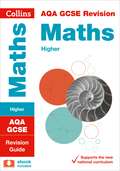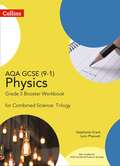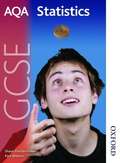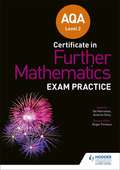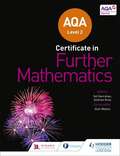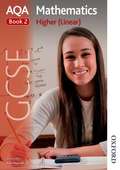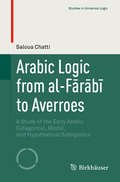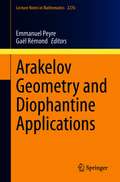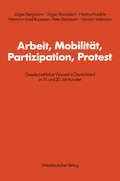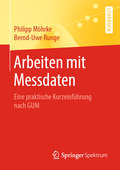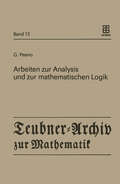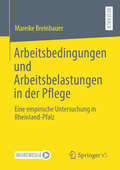- Table View
- List View
AQA GCSE Maths Higher Tier Revision Guide (Collins GCSE Revision and Practice - New Curriculum) (PDF)
by Collins Uk StaffThis Maths Revision and Practice range contains clear and accessible explanations of all the GCSE content, with lots of practice opportunities for each topic throughout the book. Based on new research that proves repeated practice is more effective than repeated study, this book is guaranteed to help you achieve the best results. There are clear and concise revision notes for every topic covered in the curriculum, plus five practice opportunities to ensure the best results. Includes:* quick tests to check understanding* end-of-topic practice questions* topic review questions later in the book* mixed practice questions at the end of the book* free Q&A flashcards to download online* an ebook version of the revision guide Suitable for the new AQA Maths GCSE.
AQA GCSE Physics 9-1 For Combined Science Grade 5 Booster Workbook (GCSE Science 9-1 Series)
by Stephanie Grant Lynn PharaohAQA GCSE Statistics (PDF)
by Shaun Procter-GreenWritten specifically for the AQA GCSE Statistic specification, our approved student book helps students to develop key statistical skills and knowledge. Structured activities and worked examples to reinforce learning. Learning objectives at the beginning of each chapter lets students know exactly what they need to learn and understand in each topic. Dedicated Controlled Assessment support helps develop investigative and analytical skills required.
AQA Level 2 Certificate Further Maths Complete Study and Practice (5-9)
by Trevor SeniorExam board: AQA. Level: GCSE Level 2. Subject: Maths. First teaching: 2018. First exam: 2020. Packed with worked examples, graded practice and exam-style questions for Grades 5-9 this book helps high achievers prepare for the new AQA Level 2 Further Maths exams with confidence.
AQA Level 2 Certificate in Further Mathematics: Exam Practice
by Val Hanrahan Andrew GintyBenefit from the expert input of experienced examiners and subject specialists in this assessment-led Practice Book, tailored to the 2018 specification and packed with exam-style questions.- Thoroughly prepare for the exam with hundreds of exam-style questions that are matched to the 2018 specification.- Get structured support and extra practice with questions focused on reasoning and problem-solving.- Check your knowledge and practise independently with full step-by-step worked solutions and mark schemes online.- Enhance learning with extra practice designed to supplement the textbooks and the My Revision Notes series.
AQA Level 2 Certificate In Further Mathematics (PDF)
by Val Hanrahan Andrew GintyExam board: AQA Level: A-level Subject: Mathematics First teaching: September 2018 First exams: Summer 2020 Stretch and challenge students with the 2nd edition of this introduction to higher level mathematics. Plenty of practice activities, worked solutions and exercise questions help students to master the mathematical reasoning skills they need to succeed and prepare for the transition from GCSE (9-1) to A-level. - Build understanding of mathematics with discussion points, thought-provoking activities and rigorous exercise questions. - Develop problem-solving skills and learn to use mathematical arguments with step-by-step worked examples. - Be mindful of possible misunderstandings; common pitfalls are noted throughout the text. - Check knowledge and understanding with a topic checklist of key points and learning objectives at the end of each chapter. - Embed understanding with free online access to narrated step-by-step examples on the Hodder Education website. - Helps students to achieve their potential with two practice papers.
AQA Level 2 Certificate in Further Maths - Exam Practice Workbook (with ans & online edition) (A^-C) (PDF)
by Cgp BooksThis CGP Workbook contains a huge range of realistic exam-style practice questions (with step-by-step answers) for the AQA Level 2 Certificate in Further Maths. It’s arranged by topic, making it easy for students to concentrate on practising the areas they find most challenging. At the end of the book, there are two full practice papers for final exam preparation. A free Online Edition of the whole book is also included - just use the unique code printed at the front of the book to access it on a PC, Mac or tablet. A matching CGP Revision Guide is also available - see 9781782941798).
AQA Mathematical Studies Workbook: Level 3 Certificate (PDF)
by Stan Dolan June HaightonWritten for students studying AQA's Level 3 Certificate in Mathematical Studies (Core Maths), this Workbook is full of dedicated, highly effective practice to help your students tackle the new exam with confidence and fluency. Structured to match to the accompanying Student Book and the AQA exam specification, this write-in Workbook provides short practice activities and mock papers suitable for all exam options, extra support for key areas that students foundchallenging in past exams, and includes two complete sets of practice exam papers. Useful links to MyMaths under each activity provide opportunites for further support and practice.
AQA Mathematics Higher (Linear): Book 2 (PDF)
by Paul MetcalfCovering the AQA 2012 GCSE linear specification, our student books have been designed to develop your students mathematical skills and encourage them to apply their knowledge in a real-life context.
Äquivariante Torsion auf Kontakt-Mannigfaltigkeiten (BestMasters)
by Pascal TeßmerPascal Teßmer verallgemeinert die von Michel Rumin eingeführte Kontakt-Torsion für den äquivarianten Fall, wobei diese Größe von der Metrik abhängt. Darauf basierend untersucht der Autor deren Verhalten in Hinblick auf eine glatte Variation der Metrik. Dabei werden auch die Fälle der fixpunktfreien und der Operation mit isolierten Fixpunkten betrachtet und explizite Variationsformeln berechnet. In der höherdimensionalen Kontaktgeometrie gehört das Finden von Größen, mit deren Hilfe Kontaktstrukturen unterschieden werden können, zu den wichtigen Aufgaben.
AQA Year 1/AS Mathematics Exam Practice
by Jan Dangerfield Rose Jewell Sue Pope Andrew Roberts Nick GeereExam board: AQALevel: A-levelSubject: MathematicsFirst teaching: September 2017First exams: Summer 2019Benefit from the expert input of experienced examiners and subject specialists including Heather Davis in this assessment-led Practice Book; tailored to the new 2017 specifications and packed with exam-style questions.- Thoroughly prepare your students for the exam with over 200 exam-style questions that are matched to the new specifications.- Provide structured support and extra practice with questions focused on problem-solving, modelling and technology.- Create opportunities for self-directed learning and assessment with answers at the back of the book, plus full step-by-step worked solutions and mark schemes supplied online.- Enhance learning with extra practice designed to supplement the textbooks and the My Revision Notes series.
Arabic Logic from al-Fārābī to Averroes: A Study of the Early Arabic Categorical, Modal, and Hypothetical Syllogistics (Studies in Universal Logic)
by Saloua ChattiThis monograph explores the logical systems of early logicians in the Arabic tradition from a theoretical perspective, providing a complete panorama of early Arabic logic and centering it within an expansive historical context. By thoroughly examining the writings of the first Arabic logicians, al-Fārābī, Avicenna and Averroes, the author analyzes their respective theories, discusses their relationship to the syllogistics of Aristotle and his followers, and measures their influence on later logical systems. Beginning with an introduction to the writings of the most prominent Arabic logicians, the author scrutinizes these works to determine their categorical logic, as well as their modal and hypothetical logics. Where most other studies written on this subject focus on the Arabic logicians’ epistemology, metaphysics, and theology, this volume takes a unique approach by focusing on the actual technical aspects and features of their logics. The author then moves on to examine the original texts as closely as possible and employs the symbolism of modern propositional, predicate, and modal logics, rendering the arguments of each logician clearly and precisely while clarifying the theories themselves in order to determine the differences between the Arabic logicians’ systems and those of Aristotle. By providing a detailed examination of theories that are still not very well-known in Western countries, the author is able to assess the improvements that can be found in the Arabic writings, and to situate Arabic logic within the breadth of the history of logic. This unique study will appeal mainly to historians of logic, logicians, and philosophers who seek a better understanding of the Arabic tradition. It also will be of interest to modern logicians who wish to delve into the historical aspects and progression of their discipline. Furthermore, this book will serve as a valuable resource for graduate students who wish to complement their general knowledge of Arabic culture, logic, and sciences.
The Arabic Version of Euclid’s Optics: Edited and Translated with Historical Introduction and Commentary Volume I (Sources in the History of Mathematics and Physical Sciences #16)
by Elaheh KheirandishLike all classical Greek texts on science, Euclid's works on optics initially came to the West mainly through medieval Arabic texts and commentaries. While several Greek versions of the Optika were discovered and translated as early as the sixteenth century, sorting out what may have been Euclid's original has not been easy. This book presents a critical translation of an Arabic texts and of Arabic commentaries on the text, and places the whole in a historical context. The Optics is particularly interesting in that Euclid's text was considerably transformed in the process of translation into Arabic "equivalents"; in addition, several of the Arabic editions of Euclid's text (c. 300 BC) contained liberal admixtures of a much later book by Ptolemy (c. 200 AD) of the same title. What was referred to as "Euclid's Optics," the "Kitab Uqlidis fi Ikhtilaf al-manazir," thus became as much an exposition of an Arabic version of a visual theory as a translation of Euclid's ideas on the subject. In preparing this edition, Dr. Kheirandish has thus not only sorted out the various manuscript versions of Al-Manazir, but also related and unrelated texts that were often confused with it.
Arakelov Geometry and Diophantine Applications (Lecture Notes in Mathematics #2276)
Bridging the gap between novice and expert, the aim of this book is to present in a self-contained way a number of striking examples of current diophantine problems to which Arakelov geometry has been or may be applied. Arakelov geometry can be seen as a link between algebraic geometry and diophantine geometry. Based on lectures from a summer school for graduate students, this volume consists of 12 different chapters, each written by a different author. The first chapters provide some background and introduction to the subject. These are followed by a presentation of different applications to arithmetic geometry. The final part describes the recent application of Arakelov geometry to Shimura varieties and the proof of an averaged version of Colmez's conjecture. This book thus blends initiation to fundamental tools of Arakelov geometry with original material corresponding to current research. This book will be particularly useful for graduate students and researchers interested in the connections between algebraic geometry and number theory. The prerequisites are some knowledge of number theory and algebraic geometry.
Arakelov Geometry over Adelic Curves (Lecture Notes in Mathematics #2258)
by Huayi Chen Atsushi MoriwakiThe purpose of this book is to build the fundament of an Arakelov theory over adelic curves in order to provide a unified framework for research on arithmetic geometry in several directions. By adelic curve is meant a field equipped with a family of absolute values parametrized by a measure space, such that the logarithmic absolute value of each non-zero element of the field is an integrable function on the measure space. In the literature, such construction has been discussed in various settings which are apparently transversal to each other. The authors first formalize the notion of adelic curves and discuss in a systematic way its algebraic covers, which are important in the study of height theory of algebraic points beyond Weil–Lang’s height theory. They then establish a theory of adelic vector bundles on adelic curves, which considerably generalizes the classic geometry of vector bundles or that of Hermitian vector bundles over an arithmetic curve. They focus on an analogue of the slope theory in the setting of adelic curves and in particular estimate the minimal slope of tensor product adelic vector bundles. Finally, by using the adelic vector bundles as a tool, a birational Arakelov geometry for projective variety over an adelic curve is developed. As an application, a vast generalization of Nakai–Moishezon’s criterion of positivity is proven in clarifying the arguments of geometric nature from several fundamental results in the classic geometry of numbers. Assuming basic knowledge of algebraic geometry and algebraic number theory, the book is almost self-contained. It is suitable for researchers in arithmetic geometry as well as graduate students focusing on these topics for their doctoral theses.
Arbeit, Mobilität, Partizipation, Protest: Gesellschaftlicher Wandel in Deutschland im 19. und 20. Jahrhundert (Schriften des Zentralinstituts für sozialwiss. Forschung der FU Berlin #47)
by Jürgen BergmannArbeiten mit Messdaten: Eine praktische Kurzeinführung nach GUM
by Philipp Möhrke Bernd-Uwe RungeDas vorliegende Lehrbuch bietet Studierenden der Natur- und Ingenieurswissenschaften einen übersichtlichen und anschaulichen Einstieg in den Umgang mit Messdaten und deren Interpretation unter Verwendung der Messunsicherheit – früher oft Fehlerrechnung genannt. Dabei stehen das Verständnis und die Vermittlung von direkt anwendbarem Wissen im Vordergrund. Auf lange mathematische Herleitungen wird weitgehend verzichtet.Auf Basis einiger einfacher Grundprinzipien wie der Verteilung der Messwerte oder dem mathematischen Modell einer Messung führt dieses Buch in zentrale Themen ein:- das Messen an sich,- die Angabe von Messergebnissen,- das Konzept der Unsicherheit,- die Auswertung von Messdaten mittels verschiedener Methoden,- sowie die Bewertung der erhaltenen Ergebnisse.Alle diese Themen werden anhand vielfältiger Beispiele ausführlich dargestellt und die Anwendung der abstrakten Konzepte anhand konkreter Zahlenbeispiele veranschaulicht. Fragen zur Selbstkontrolle sowie zur Vertiefung der Inhalte runden jedes Kapitel ab.
Arbeiten mit ökonometrischen Modellen (Studies in Contemporary Economics)
by Werner Gaab Ullrich Heilemann Jürgen WoltersDas vorliegende Buch ist eine Einführung in die praktische Arbeit mit makroökonometrischen Modellen. Die Autoren sind auf dem Feld international ausgewiesene Wissenschaftler. Die Beiträge thematisieren alle Aspekte des Verständnisses der statistisch/ökonometrisch und ökonomisch-theoretischen Grundlagen makroökonometrischer Modelle, ihrer Wirkungsbeziehungen sowie ihrer Prognose- und Simulationsleistungen. Die Beiträge sind für sich verständlich und wenden sich an Interessierte, ohne spezifische statistische oder ökonometrische Vorkenntnisse vorauszusetzen. Der Leser kann die wichtigsten Methoden und Verfahren anhand der allgemein verfügbaren Verfahren und Daten sowie des verwendeten makroökonometrischen Modells leicht nachvollziehen. Das verwendete Modell ist das RWI-Konjunkturmodell, ein mittelgroßes makroökonometrisches Modell für die Bundesrepublik Deutschland, das seit mehr als 25 Jahren regelmäßig für Prognosen und Simulationen Anwendung findet.
Arbeiten zur Analysis und zur mathematischen Logik (Teubner-Archiv zur Mathematik #13)
by Giuseppe PeanoDieser Band enthält fotomechanische Nachdrucke klassischer Arbeiten von Giuseppe Peano zur Analysis und zur mathematischen Logik aus den Jahren 1886 bis 1899, denen für die Herausbildung der gegenwärtigen Mathematik große Bedeutung zukommt. Im Nachwort berichtet der Herausgeber über die Entstehungsgeschichte der abgedruckten Arbeiten, über deren Stellung im Gesamtwerk Peanos und über ihre Verflechtung mit der Entwicklung der Mathematik um die Jahrhundertwende. Fotos und Archivalien komplettieren das Buch. Aus den Besprechungen: "Die mathematische Behandlung der Grundlagen der Mathematik ... ist aus der Verbindung zweier verschiedener Forschungsrichtungen ... hervorgegangen. Einerseits das Werk der Meister der Analysis und der Geometrie, sofern sie ihre Axiome formulierten und systematisierten, und das Werk von Cantor und anderen über Gebiete wie die Mengentheorie. Andererseits die symbolische Logik, die nach der notwendigen Entwicklungsperiode jetzt dank Peano und seinen Nachfolgern die technische Verwendbarkeit und logische Bündigkeit erreicht hat, die wesentlich sind für ein mathematisches Hilfsmittel zur Behandlung dessen, was bisher die Grundlagen der Mathematik gebildet hat." A.N. Whitehead, B. Russell#1
Arbeits- und Übungsbuch Wirtschaftsmathematik: Beispiele - Aufgaben - Formeln (Teubner Studienbücher Mathematik)
by Bernd Luderer Cornelia Paape Uwe WürkerMathematisches Wissen sollte auf aktivem Wege erworben werden. Das Arbeits- und Übungsbuch Wirtschaftsmathematik unterstützt diese Aktivität und eignet sich somit in besonderer Weise zum Selbststudium und zur intensiven Prüfungsvorbereitung auf das Fach Mathematik innerhalb eines wirtschaftswissenschaftlichen Studiums. Das Buch liefert zu vielen Gebieten der Mathematik, für die sich Anwendungen in Wirtschaftstheorie und Wirtschaftspraxis ergeben, die notwendigen Grundlagen. Zu jedem der behandelten Themen werden nach einer Motivation und Nennung der wichtigsten Begriffe die hauptsächlich benutzten Formeln angegeben und voll durchgerechnete und ausführlich kommentierte Beispiele angeboten. Wesentlicher Bestandteil ist die umfangreiche Aufgabensammlung, mit deren Hilfe der aktive Wissenserwerb angestrebt werden kann. Eine Selbstkontrolle ist durch die beigegebenen Lösungen im Anhang des Buchs gewährleistet.
Arbeits- und Übungsbuch Wirtschaftsmathematik: Beispiele - Aufgaben - Formeln
by Bernd Luderer Cornelia Paape Uwe WürkerMathematisches Wissen sollte auf aktivem Wege erworben werden. Das Arbeits- und Übungsbuch Wirtschaftsmathematik unterstützt diese Aktivität und eignet sich somit in besonderer Weise zum Selbststudium und zur intensiven Prüfungsvorbereitung. Voll durchgerechnete und ausführlich kommentierte Beispiele helfen beim Training des Stoffes. Wesentlicher Bestandteil ist die umfangreiche Aufgabensammlung mit Lösungen.
Arbeits- und Übungsbuch Wirtschaftsmathematik: Beispiele - Aufgaben - Formeln (Teubner Studienbücher Mathematik)
by Bernd Luderer Cornelia Paape Uwe WürkerAusführlich diskutierte beispiele, Aufgaben und Lösungen zu allgemeinen mathematischen Grundlagen sowie zu wesentlichen Abschnitten aus Analysis. Linearer Algrebra, Linearer Optimierung und Finanzmathematik für Sozial- und Wirtschaftswissenschaftler, ergänzt mit wichtigen Formeln, Motivationen und Hinweisen.
Arbeits- und Übungsbuch Wirtschaftsmathematik: Beispiele - Aufgaben - Formeln (Studienbücher Wirtschaftsmathematik)
by Bernd Luderer Cornelia Paape Uwe WürkerAusführlich diskutierte Beispiele, Aufgaben und Lösungen zu allgemeinen mathematischen Grundlagen sowie zu wesentlichen Abschnitten aus Analysis, Linearer Algebra, Linearer Optimierung und Finanzmathematik für Wirtschaftswissenschaftler, ergänzt mit wichtigen Formeln, Übersichten und Hinweisen.
Arbeitsbedingungen und Arbeitsbelastungen in der Pflege: Eine empirische Untersuchung in Rheinland-Pfalz
by Mareike BreinbauerZiel dieser Studie ist es, die Situation der beruflichen Pflege aus Sicht der Pflegekräfte in Rheinland-Pfalz nachzuzeichnen. Es soll die zentrale Frage beantwortet werden, wie die Pflegekräfte ihren Berufsalltag und die Arbeitsbedingungen in der Pflege wahrnehmen. Der Schwerpunkt liegt auf der Untersuchung der wahrgenommenen Arbeitsbelastungen, dem selbsteingeschätzten Burnout-Risiko, den eingesetzten Bewältigungsstrategien sowie der Arbeitszufriedenheit. Als Datenbasis dient eine Online-Erhebung unter den Mitgliedern der Landespflegekammer Rheinland-Pfalz (n=830) aus dem Jahr 2017. Insgesamt zeigt sich, dass die Pflegenden der Studie besonderen Belastungen ausgesetzt sind, die sich aus mannigfaltigen Faktoren ergeben. Beispielsweise aus einer zu geringen Personalausstattung und damit einhergehender Arbeitsverdichtung und zunehmendem Arbeiten unter ständigem Zeitdruck. Neben den Problemen und Risiken bietet die Arbeit in der Pflege aber auch Chancen, welche die hohen Risiken kompensieren und sich gesundheitsförderlich auswirken können. Hierzu zählen individuelle Ressourcen und ein gutes Bewältigungsmanagement. Die Studie liefert einerseits neue Erkenntnisse zur Situation der beruflich Pflegenden in Rheinland-Pfalz und stützt anderseits bereits bestehende Befunde zu den Arbeitsbedingungen und Arbeitsbelastungen in der Pflege allgemein.
